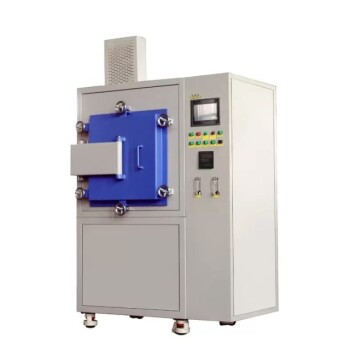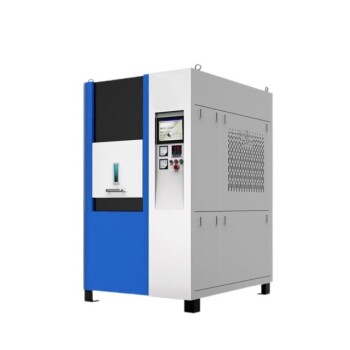At their core, IGBT modules dramatically increase the efficiency of melting machines by minimizing wasted energy and enabling superior process control. This is achieved through their unique electrical properties, specifically a low on-state voltage drop which reduces power dissipated as heat, and a high switching frequency that allows for rapid, precise adjustments to the melting process.
The true benefit of IGBT technology in melting isn't just lower electricity bills. It's the conversion of electrical efficiency into tangible operational advantages: faster production cycles, higher-quality final products, and a more streamlined, cost-effective process.
The Core of IGBT Efficiency: How It Works
To understand the benefits, we must first look at the fundamental electrical advantages IGBTs (Insulated Gate Bipolar Transistors) bring to an induction furnace's power supply.
Lower Energy Loss as Heat
IGBTs are designed to have a very low on-state voltage drop. This means that when the module is conducting electricity, it wastes very little energy in the form of heat.
This inherent efficiency directly translates to lower overall energy consumption and reduced cooling requirements for the power electronics cabinet.
High-Frequency Switching
IGBTs can switch on and off thousands of times per second. This high switching frequency is critical for induction heating.
It allows the power supply to precisely modulate the energy delivered to the melt, enabling faster heating and extremely accurate temperature control that older technologies cannot match.
Simplified and More Reliable Circuitry
Older power systems, like those using SCRs (Silicon Controlled Rectifiers), often require complex snubber circuits to protect the components. These circuits add complexity and are another source of energy loss.
IGBT-based designs do not require these snubber circuits. Their driver circuits are also simpler because they are voltage-controlled, leading to a more reliable, cost-effective, and lower-maintenance system.
Translating Electrical Efficiency into Operational Gains
The electrical advantages of IGBTs create a cascade of positive effects throughout the entire melting operation, moving beyond simple power savings to improve product quality and throughput.
Faster Melting Times
The ability to deliver precisely controlled, high-frequency power allows the furnace to ramp up to temperature much faster. This directly shortens the melting cycle.
Faster melt times mean higher throughput and greater productivity from the same equipment footprint.
Unmatched Process Control
The rapid switching capability of IGBTs gives operators fine-grained control over the melting process. Temperature can be held within very tight tolerances.
This precision is crucial for working with specialized alloys in demanding industries like aerospace and medical, where material composition must be exact.
Improved Metallurgical Quality
The electromagnetic field generated by the IGBT power supply creates a natural stirring force within the molten metal.
This stirring action promotes a uniform temperature and chemical composition throughout the melt. It helps impurities and scum rise to the surface for easier removal, resulting in a cleaner, brighter final casting with significantly reduced risk of defects like porosity or shrinkage.
Common Pitfalls to Avoid
While highly beneficial, maximizing the advantages of IGBT technology requires a holistic system view. Focusing solely on the module itself is a common mistake.
Ignoring System Integration
The IGBT is the heart of the power supply, but its performance depends on the entire system. A poorly designed induction coil, an inadequate cooling system, or an unstable main power source can all negate the benefits.
Effective implementation requires that all components are designed to work together to leverage the IGBT's speed and efficiency.
Overlooking Harmonic Distortion
All high-frequency switching devices can introduce harmonic distortion back into the electrical grid. While modern IGBT furnaces have low harmonic pollution compared to older systems, it is not zero.
Failing to account for facility-wide power quality can lead to issues with other sensitive equipment. Proper filtering and installation are essential.
Making the Right Choice for Your Goal
Adopting IGBT-based melting technology is a strategic decision. Your primary operational goal will determine which benefits are most critical for you.
- If your primary focus is cost reduction: The key benefits are direct energy savings from higher electrical efficiency and lower maintenance costs from simplified, more reliable circuitry.
- If your primary focus is product quality: The unparalleled temperature control and electromagnetic stirring will deliver a more uniform, cleaner melt, which is essential for high-specification alloys.
- If your primary focus is production throughput: The significant reduction in melting times will allow you to process more material and increase the overall output of your facility.
Ultimately, upgrading to an IGBT-powered melting furnace is a step toward a faster, more precise, and more profitable operation.
Summary Table:
| Key Benefit | How IGBTs Achieve It | Operational Impact |
|---|---|---|
| Lower Energy Loss | Low on-state voltage drop reduces heat waste | Reduced electricity bills & cooling needs |
| High-Frequency Switching | Rapid on/off cycles (thousands per second) | Faster melting times & precise temperature control |
| Simplified Circuitry | No snubber circuits; voltage-controlled design | Higher reliability & lower maintenance costs |
| Electromagnetic Stirring | Optimized electromagnetic field in the melt | Uniform temperature & composition; cleaner final product |
Ready to transform your melting operation with the efficiency of IGBT technology?
At KINTEK, we leverage our deep expertise in thermal processing and in-house manufacturing to deliver advanced melting solutions tailored to your unique needs. Whether your goal is to reduce energy costs, improve product quality for high-specification alloys, or increase production throughput, our IGBT-based systems are engineered for superior performance and reliability.
Our product line, including high-temperature furnaces and custom systems, is backed by strong R&D and deep customization capabilities to ensure your melting process is faster, more precise, and more profitable.
Contact us today to discuss how a KINTEK IGBT melting solution can benefit your laboratory or production facility!
Related Products
- Vacuum Induction Melting Furnace and Arc Melting Furnace
- Laboratory Muffle Oven Furnace with Bottom Lifting
- 1700℃ High Temperature Laboratory Tube Furnace with Quartz or Alumina Tube
- 1800℃ High Temperature Muffle Oven Furnace for Laboratory
- High Temperature Muffle Oven Furnace for Laboratory Debinding and Pre Sintering
People Also Ask
- What are the advantages of vacuum induction melting compared to other methods? Achieve High-Purity Metals for Critical Applications
- How is operator safety ensured during the vacuum induction melting process? Discover Multi-Layered Protection for Your Lab
- How does induction heating work in a Vacuum Induction Melting Furnace? Unlock High-Purity Metal Melting
- What are the key benefits of using vacuum melting furnaces? Achieve Superior Purity and Control for High-Performance Alloys
- What additional advantages do vacuum induction melting furnaces provide? Achieve Ultra-Pure Metals for Critical Applications



















